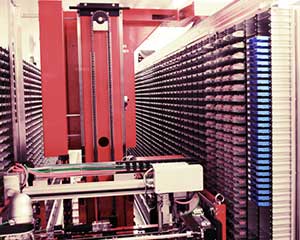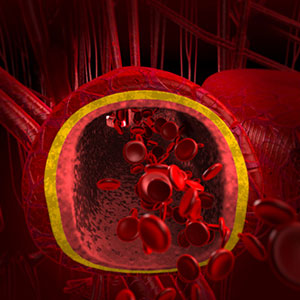New Facilities Underscore Commitment to Excellence

By providing investigators with cutting-edge technology and centralized resources, the two new core facilities established this fiscal year at The Children’s Hospital of Philadelphia Research Institute underscore the Institute’s longstanding commitment to medical innovation, and reinforce its reputation as one of the world’s leading pediatric research institutions.
The new facilities are the DNA-sequencing facility BGI@CHOP, a groundbreaking collaboration with Beijing-based genomics institute BGI; and a biorepository, a library of samples and data. Through its more than a dozen “core” facilities, the Research Institute provides investigators with instrumentation and technical skill to service research programs.
“With the establishment of the BGI@CHOP and biorepository cores, investigators at CHOP will be empowered to conduct genomic research using state-of-the-art technologies on the full range of pediatric diseases that afflict our patients,” noted Tom Curran, PhD, FRS, deputy scientific director at CHOP Research. “This research will pave the way to provide personalized medicine for all children,” Dr. Curran added.
BGI is a world leader in high-throughput sequencing (HTS), a next-generation method of DNA sequencing that reduces sequencing time and costs, and can produce multiple sequences simultaneously. In the near future, using technology like HTS, an entire human genome will be able to be sequenced in under a day, for less than $1000. As part of the BGI@CHOP partnership, BGI has provided the Research Institute with a number of HTS sequencers. By focusing its efforts on larger scale genome and exome sequencing projects, the BGI@CHOP core complements the nucleic acid sequencing services provided by the already well-established Nucleic Acid and Protein core.
“BGI@CHOP combines the capabilities and experience of BGI, the world’s largest genomics institute, with our extensive biobanking efforts at CHOP and expertise in clinical phenotyping. The partnership will accelerate the discovery of genes underpinning both rare and common pediatric diseases using next-generation sequencing, and will allow researchers to harness the power of large, detailed data sets,” said Hakon Hakonarson, MD, PhD, director of the Center for Applied Genomics and faculty advisor of BGI@CHOP.
Calling the establishment BGI@CHOP an “ideal collaboration,” Philip Johnson, MD, chief scientific officer at Children’s Hospital, said the partnership with BGI is an “important first step” in changing the way we treat pediatric diseases.
The biorepository core, meanwhile, collects and organizes biospecimens from investigators across the Research Institute. The biorepository helps to anticipate investigators’ requests, avoid specimen duplication, preserve materials, and provides broad access to data and materials.
With a capacity for approximately 5 million samples, the biorepository is designed to house all of the biospecimens available at Children’s Hospital. While DNA samples may eventually make up the bulk of the biorepository’s holdings, with the addition of other freezers in the near future it will also be able to store fluids, RNA, tissue samples, and other biospecimens.
CHOP Spin-Off Raises $7 Million

Over the past decade, Robert J. Levy, MD, the William J. Rashkind Endowed Chair in Pediatric Cardiology, and his team have investigated a new approach to stent-based therapy that uses magnetically guided nanoparticles to deliver drugs to diseased blood vessels.
The technology led to the Hospital’s first startup company, called Vascular Magnetics Inc. (VMI), which was founded in 2010. And last year, Devon Park Bioventures, of Wayne, Pa., invested $7 million in the company to advance development of an innovative drug delivery system to treat peripheral artery disease, or PAD.
The drug delivery system at the heart of the company’s work is called vascular magnetic intervention. The system combines biodegradable, magnetic drug-loaded particles with a magnetic targeting catheter and a device that creates a uniform magnetic field. The system, which Levy has tested in animals, guides the particles to the walls of arteries narrowed by PAD. At the disease site, the particles remain in place, slowly biodegrading and releasing the drug paclitaxel, which prevents re-obstruction of the artery.
Vascular magnetic intervention could fill an important unmet need in treating PAD, in which blocked arteries, primarily in the legs, exact a heavy toll in some 30 million older adults in North America and Europe. Diabetes patients and smokers are particularly affected by this painful, debilitating condition, which is responsible for the majority of amputations performed in this country.
Drug-eluting stents, currently used in heart disease, are less effective in PAD. Magnetic intervention could deliver more effective doses of drugs than the standard drug-eluting stents, and could be used to re-administer drugs as needed, Dr. Levy said.
As a new platform technology, vascular magnetic intervention could also be adapted to delivering other agents, such as therapeutic genes or cells, and has potential utility in treating heart conditions in children, Dr. Levy added. In the near future, Vascular Magnetics will complete preclinical development of its technology, and plans to conduct its first clinical trial in 2014, in adult patients.
The Human Genome — Yep, There’s an App for That!

It’s been nearly a decade since scientists completed the Human Genome Project — a scientific marvel that, in its essence, provided the blueprint for the genetic make-up of humans. It was quite an accomplishment, given the 3 billion chemical base pairs that make up the human genome and the tens of thousands of genes in our DNA.
Now the results of the Human Genome Project are at your fingertips — literally.
With the iPad® application Genome Wowser, investigators can quickly and efficiently navigate the vast information on the human genome. Developed by the Center for Biomedical Informatics (CBMi) at Children’s Hospital, Genome Wowser provides for the convenient, intuitive, and highly mobile exploration of genomic information.
Anyone with an iPad® can download the free app from the iTunes App Store℠ online. From there it’s simple to traverse the entire human genome — just like planning a travel route on Google Maps.
A common use for the tool is to enter the name of a gene in Wowser’s search box. The app finds the gene on one of the 23 human chromosomes, displaying an interactive image of its precise location among the genome’s 3 billion base pairs.
Another valuable feature of the app are from investigators about the known or suspected biological functions, identified mutations and variants of each gene. Users can find information about neighboring genes or about epigenetics — how a gene’s functions are modified when chemicals attach or separate from exposed sections of DNA. Touching the screen (by pinching and spreading one’s fingers) allows a user to zoom in or out of the chromosome region.
Genome Wowser’s name plays on the name of the data source that it emulates — the venerable UCSC Genome Browser, a website established in 2000 at the University of California Santa Cruz that serves as a popular worldwide data repository and genome exploration tool for human genome data. This information is constantly being updated as scientists uncover new gene data.
“With this app, researchers can now access genomic data from anywhere with minimal effort, and they can immediately explore the genome visually by using the intuitive screen touches and gestures that have made the iPad® platform so powerful,” says CBMi director Peter White, PhD.
Genome Wowser supports viewing and querying multiple types of genomic data, so users can select the information that interests them and view the data concurrently in a stacked display for a selected region. In addition to text-based and graphical search options, the app provides zooming capabilities for its genome graphics, and drag-and-swipe navigation to move seamlessly across a chromosome.
Perhaps most importantly, Genome Wowser allows convenient portability of genomic data.
“With this app, I can hear about an interesting disease gene at a seminar and see its genomic and functional contexts in a few screen touches, including epigenetic and variation profiles, neighboring genes, and other critical associations you can’t determine from a simple web search,” says Dr. White. “Then, I can walk over to a colleague and share it with them, all in a few seconds.”
Since its launch, Genome Wowser has been consistently ranked as a top 10 “What’s Hot” medical app on iTunes, downloaded more than 7,000 times and updated more than 25,000 times from researchers in 79 countries. A second version of the app, released in August 2012, includes access to the genome sequences of more than three dozen non-human species, including dogs, cats, mice, chimpanzees, elephants, and 11 species of fruit fly, plus further improvements in the touch interface.
Genome Wowser, which now has its own Facebook page, has been featured in numerous media outlets, including Popular Science, Forbes, and even on MTV. It was also cited in a recent book by Eric Topol, MD, titled, “The Creative Destruction of Medicine: How the Digital Revolution Will Create Better Health Care.”
New Program Exposes Students to Research

Advancing research at Children’s Hospital doesn’t just revolve around recruiting world-class investigators and providing the best possible facilities and resources to foster collaboration and accelerate discoveries.
Such discoveries — aimed at improving the health and well-being of children and contributing to the collective scientific knowledge — are always the end goal. But CHOP Research has never lost sight of the importance of not only the needs of those with established research programs, but also those who will soon be stepping into the research ranks to serve as the next generation of investigators.
CHOP Research has long been committed to finding, training, and mentoring the best and brightest students who have a passion for biomedical research, and whose future discoveries may alter the landscape of available therapies and treatments for children.
As part of this commitment, the Institute launched a new, highly competitive program in June 2012 aimed at giving undergraduate students valuable experience in biomedical science, and introducing the Institute as a premier setting to train and work.
The CHOP Research Institute Summer Scholars Program (CRISSP) aims to foster student interest in biomedical research as a career. While other institutions offer summer programs for undergraduates, CHOP’s program is unique because of its pediatric research focus.
Applicants reviewed the profiles of faculty members participating in CRISSP and identified those whose research programs were best aligned with their interests. Fifteen undergraduate students from numerous institutions — including Princeton University, Swarthmore College, the University of Pennsylvania, Villanova University, and Franklin & Marshall College, among others — were ultimately selected from nearly 300 applicants to form the pilot CRISSP scholars group.
Each CRISSP scholar was paired with a faculty “host” for the duration of the 10-week program and completed an independent research project that they presented at the end of the summer. The projects among the students varied from specialized techniques in laboratories to learning how best to interact with patients and families in a clinic. All of the students reported enhanced research skills as a result of taking part in the program.
“Not only have I become comfortable with such techniques as plasmid transformation, tissue culture work, transfection, and Western immunoblotting, but I feel confident that I will be able to apply these skills to my own research in the future,” said Joana Petrescu of Villanova University, whose mentor was Matt Weitzman, PhD.
And investigators who served as mentors heralded the success of the program.
“Our goal as faculty was to give an opportunity to bright and serious students to learn and carry out biomedical research but in fact, I believe we gave as much as we received from the CRISSP scholars,” says Maurizio Pacifici, PhD. “What each was able to accomplish is 10 weeks is truly impressive, and their passion and long-term commitment are beyond doubt. The program is indeed inspiring the next generation of researchers.”
Fifteen students will again be selected as 2013 CRISSP scholars, with plans for expanding the program in 2014.
Researcher’s Gene Chip Proves Helpful Data Source

A DNA chip created by a Children’s Hospital scientist has been used as an important research tool for geneticists analyzing genes that play a role in heart disease — as well as other complex, common metabolic diseases.
Brendan Keating, PhD, of the Center for Applied Genomics, conceived and developed the cardiovascular gene array to collect signals from gene variants that raise the risk of coronary artery disease (CAD) and heart attacks — myocardial infarctions (MI).
The DNA chip, also called an array, contains millions of micron-sized beads holding specific DNA probes for genetic variants of interest. When a test sample, such as DNA to be analyzed, is brought into contact with the chip, the sites at which test DNA binds to matching probes in the chip lets investigators identify specific DNA sequences occurring in the test sample.
An international consortium of scientists, led by British Heart Foundation researchers recently used Dr. Keating’s chip to help discover five new gene variants associated with susceptibility to coronary heart disease. When added to existing heart-related genes, the findings may contribute eventually to helping identify individuals at high risk of developing CAD — the most common cause of premature death and disability worldwide.
At the time of the array design in 2006 there were few robust signals known for CAD and MI, and there was much controversy about the strength of some of the findings already published.
“This low-cost array allowed many research groups to pool appropriately collected CAD and MI cases and controls, and to meta-analyze these datasets together,” says Dr. Keating, a co-author of the study by the international consortium. “This study reinforces the value of large-scale collaboration of international groups in the cardiovascular community to discover new genes that may become useful targets for therapy.”
Dr. Keating’s cardiovascular gene chip has also been used for other studies nearing completion by large consortiums, including those investigating type 2 diabetes, stroke, lipids and body mass index.





